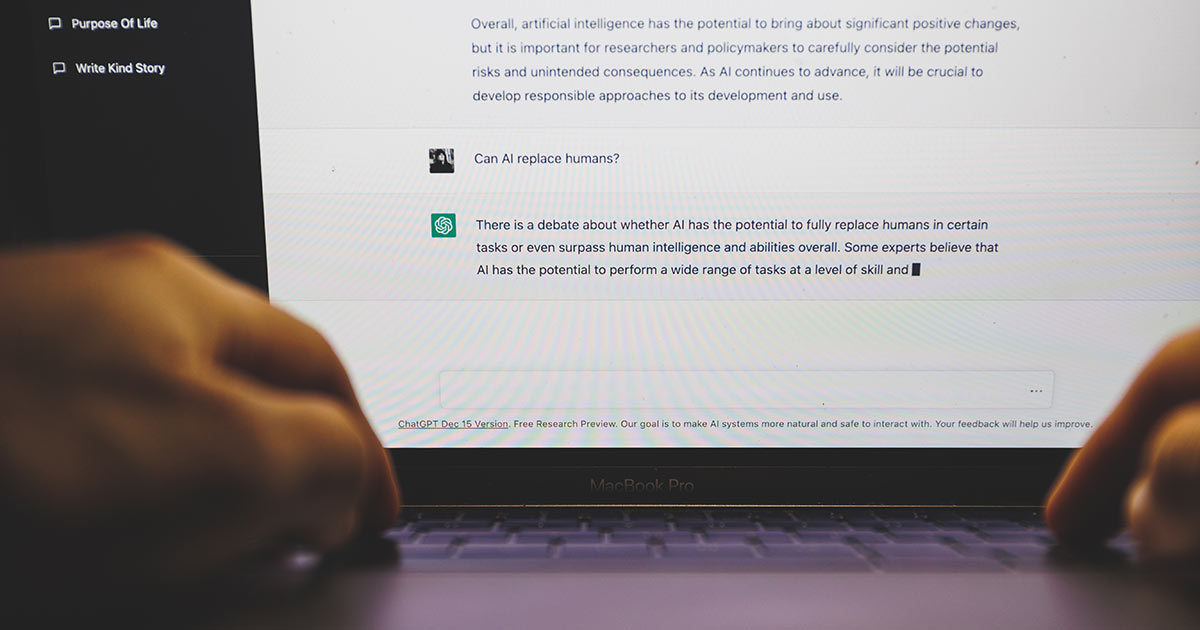We’ve entered a new age of digital marketing… Welcome to the world of content marketing shaped by artificial intelligence (AI)!
While AI can enhance efficiency, save time, cut costs, and personalize content, it’s important to find the right balance between innovation, creativity, and ethics. In this blog, we’ll explore the importance of responsible and ethical practices when using AI to generate ideas, polish content, and support writers.
We’ll discuss potential drawbacks and best practices for accurate, unbiased, and audience-appropriate content when using AI.
Plus, we’ll highlight the vital role of human oversight and independent thought in ensuring high-quality content that meets ethical standards.
Get ready to unleash the power of AI responsibly and take your marketing efforts to new heights!
Understanding How AI is Used in Content Creation
While there are many different definitions of what artificial intelligence is, global marketing and consulting firm McKinsey describes AI as “a machine’s ability to perform the cognitive functions we usually associate with human minds.” More generally, AI refers to the branch of computer science that focuses on the development of intelligent machines capable of performing tasks that typically require human intelligence.
When it comes to content creation, AI tools like ChaptGPT, DALL-E-2, JasperAI, AdCreative.ai, and Grammarly use advanced algorithms and machine learning techniques to automate various aspects of the content generation process.
AI can be used in content creation to streamline workflows, optimize productivity, and enhance the quality of content through idea generation. It can assist marketers and content creators in generating, customizing, and individualizing content across various platforms and channels.
It’s important to note that while AI can significantly improve content creation processes, it is not a substitute for human creativity, intuition, and critical thinking. The effective use of AI in content creation involves striking a balance between automation and human oversight to ensure that the content produced is of high quality, relevant, and aligns with the intended brand message.
Here are a few key applications and benefits of AI in content creation:
- Content Ideation and Generation
AI algorithms can generate content topics, outlines, articles, product descriptions, social media posts, press releases, and other forms of content based on predefined templates, data inputs, and learned user preferences. This enables the creation of large volumes of content efficiently and at scale.
- Personalization
AI algorithms can analyze user data, behavior patterns, and preferences to deliver personalized content recommendations and experiences. By tailoring content to individual users or brands, AI can help engage a brand’s target audience more effectively with personalized data inputs.
- Natural Language Processing (NLP)
AI-powered NLP techniques enable machines to understand and interpret human language. This allows for automated content summarization, sentiment analysis, language translation, and chatbot interactions.
- Data Analysis
AI algorithms can analyze vast amounts of data to identify trends, insights, and patterns. This helps marketers understand audience preferences, optimize content strategies, and make data-driven decisions.
- Image and Video Processing
AI technologies, such as computer vision, enable the automatic recognition, tagging, and analysis of images and videos. This enhances content curation, visual storytelling, and personalized visual experiences.
In the following sections, we will delve deeper into the benefits and potential drawbacks of using AI in content creation, explore ethical considerations, and provide best practices to ensure that AI-generated content is accurate, unbiased, and appropriate for the intended audience.
Benefits and Potential Drawbacks of Using AI in Content Creation
AI offers a range of benefits that can revolutionize content creation and marketing strategies. However, it’s important to be aware of the potential drawbacks and limitations as well. Let’s explore both sides of the coin.
Benefits of Using AI in Content Creation
- Increased Efficiency and Productivity
AI-powered content creation tools automate repetitive tasks, allowing marketers to generate content at a faster pace. This saves time and resources, enabling teams to focus on higher-value activities such as strategy and creativity.
- Cost-Effectiveness
By automating content creation processes, AI can reduce operational costs associated with hiring and managing a large content production team. Businesses can generate content at scale without significant increases in expenses.
- Personalization and Customization
AI algorithms analyze user data, behavior, and preferences to deliver personalized content experiences. By tailoring content to users’ interests and needs, businesses can enhance customer engagement, conversion rates, and overall user satisfaction.
Potential Drawbacks of Using AI in Content Creation
- Lack of Creativity and Human Touch
AI algorithms excel at generating content based on patterns and existing data. However, they may struggle with originality, creativity, and understanding context as effectively as human creators. AI-generated content may lack the human touch and emotional resonance that can be crucial in building genuine connections with audiences.
- Plagiarism or Inaccuracies in Content
Without proper oversight, AI-generated content may unintentionally plagiarize information if it pulls from sources without proper citation. Additionally, AI relies on existing data, which may not always capture the most recent, relevant, or accurate information. As AI algorithms learn from historical data, they may overlook emerging topics or fail to stay up-to-date with rapidly evolving industries.
- Ethical Concerns and Potential Biases
AI algorithms are trained on vast amounts of data, which may inadvertently contain biases or reflect societal prejudices. If not carefully monitored and addressed, AI-generated content can perpetuate stereotypes or discriminate against certain groups. It is essential to ensure ethical AI practices and review content for potential biases through a human lens.
- Impact on Human Workers
As AI becomes more prevalent in content creation, there may be concerns about job displacement. While AI can automate certain tasks, human involvement, and expertise remain essential for creative ideation, strategy, and maintaining quality standards. Businesses should focus on upskilling and reskilling employees to work alongside AI rather than being replaced by it.
Despite these potential drawbacks, when used responsibly, thoughtfully, and in conjunction with human oversight, AI can significantly enhance content creation processes, improve efficiency, and deliver personalized experiences that engage audiences.
Best Practices for Ensuring Accurate, Unbiased, and Appropriate AI-Generated Content
By implementing best practices, you can mitigate potential biases and maintain high-quality standards in your content creation. Here are a few things to consider when optimizing the way you use AI.
- Train and Fine-Tune AI Models
Continuously train and refine AI models using diverse and representative datasets to improve accuracy and reduce biases.
- Verify Data Quality and Diversity
Ensure the quality and diversity of training data to avoid skewed outcomes. Consider diverse perspectives and inputs to create content that resonates with a wider audience.
- Monitor and Evaluate Regularly
Monitor AI-generated content regularly to identify any issues or biases, especially related to race, gender, and other marginalized characteristics. Take necessary steps to minimize and correct any identified biases and implement mechanisms for ongoing evaluation and improvement to maintain accuracy and relevance.
- Seek User Feedback and Make Iterative Improvements
Encourage user feedback to identify areas of improvement and refine AI-generated content based on user preferences and needs.
- Ensure Compliance with Legal and Industry Regulations
Stay updated with legal and industry guidelines concerning content creation, privacy, ethics, plagiarism, and data protection to ensure compliance. Obtain explicit consent for any data usage and inform users about how their information is used to personalize content. Then, consider incorporating an AI usage policy in your organization to spell out exactly how you will utilize AI tools.
The Role of Effective Human Oversight and Review
Effective human oversight is crucial in maintaining quality and ethical standards in AI-generated content. Human reviewers and content experts should be involved in the review process to ensure accuracy, context, and adherence to brand guidelines. Combining AI capabilities with human creativity, intuition, and judgment can help create well-rounded and impactful content.
By incorporating these ethical considerations and implementing best practices, businesses can ensure that AI-generated content remains accurate, unbiased, and appropriate for their intended audience.
Elevate your Marketing Efforts with Responsible AI
As the power of AI in content creation continues to grow, responsible and ethical practices become paramount. By leveraging AI effectively, businesses can unlock efficiencies, personalize content, and engage audiences.
However, it is essential to maintain a balance between innovation and ethics. Addressing biases, ensuring compliance, and having effective human oversight is vital for ensuring accurate, unbiased, and appropriate AI-generated content.
By adhering to best practices and being mindful of ethical considerations, businesses can harness the full potential of AI while building trust, credibility, and meaningful connections with their target audience. Embrace the possibilities of AI, but always do so responsibly to elevate your marketing efforts to new heights.
PS– As a real-world example… AI might have even helped write this blog 😉





